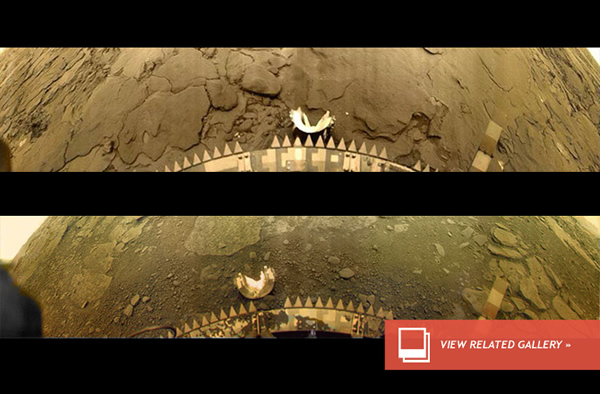When the Veneras Challenged Venus' Hellish Atmosphere
When the Veneras Challenged Venus' Hellish Atmosphere
In the early space age, even before President Kennedy kicked off the race to the moon, the United States and the Soviet Union had begun exploring our closest planetary neighbors.
Both nations got off to somewhat rocky starts, but by the 1970s enjoyed great success; for the Americans this came on Mars and for the Soviets this came on Venus with the Venera program. Not only did Venera see spacecraft land on the foreboding planet’s surface, these landers returned pictures. The twin Veneras 11 and 12 landers are celebrating their 35th anniversary this month.
After experiencing a string of failures on Mars and learning that NASA planned to land the twin Viking landers on the red planet in 1976 for the country’s bicentennial, director of the Soviet Space Research Center agency Roald Sagdeev urged the Soviet Space Program to pick a different goal: Venus. And he didn’t want to see spacecraft simply fly past the planet, he wanted landers to touch down on the surface and take pictures. Returning the first image from another world would be another first for the Soviets in space.
The Venera program was already in place to see this goal realized. It had started with Venera 1 in 1961, a mission that launched successfully but failed to reach its target. Venera 2 launched in 1965 and managed a successful flyby.
Veneras 3 through 8 were primarily data gathering missions. These spacecraft released probes into the Venusian atmosphere designed to gather data as they fell to the surface. It was these probes that told the Soviets just how fortified their photographing landers would need to be; they revealed the surface temperature to be close to 900 degrees Fahrenheit and the pressure of the carbon dioxide-rich atmosphere to be about 92 times that of Earth’s.
Beginning with Venera 9, the instrument module of the spacecraft was cylindrical with all the instrumentation inside. This sat on top of an engine, which was surrounded by a circular structure that acted as an air brake; the Venusian atmosphere was so thick that after using a parachute for the first phase of descent, the lander could fall freely to the surface. Shock absorbers at the bottom of the lander softened touchdown.
The spacecraft and its uncommon parachute-free landing system worked. Venera 9 landed successfully and sent back the first picture of another world. So did Venera 10. Veneras 11 and 12 didn’t; the lens caps covering the cameras failed to release. But the goals for these missions went beyond photographing the surface.
Venera 11, which launched on Sept. 9, 1978, and Venera 12, which launched five days later on Sept. 14, were both flyby missions that deployed landers to the surface. And both spacecraft carried two dedicated gamma ray burst detectors as part of a French-Soviet collaboration: the SIGNE 2 experiment and the Konus experiment.
The SIGNE 2 project consisted of three French-built gamma ray detectors, one each on Veneras 11 and 12, and a third on the Soviet satellite Prognoz 7, a satellite that was launched into a highly elliptical Earth orbit on Oct. 30, 1978. Taken together, these 3 satellites formed an interplanetary gamma-ray burst triangulation network. It was the first time identical detectors had been used simultaneously for gamma-ray burst detection on separate spacecraft over such significant distance, and they were the largest such detectors launched into space.
The KONUS experiment consisted of six scintillation detectors, six devices for gamma-ray burst detection against the cosmic background, six counters, and a time analyzer.
These two missions, in spite of instrument failures, sent back valuable data. Veneras 11 and 12 both flew by Venus at a distance of about 22,000 miles, measuring the solar wind, gamma-ray bursts, ultraviolet radiation, and Venus’ ionosphere. And both spacecraft’s corresponding landers reached the surface in one piece and fared quite well, though in addition to the lens caps staying put the soil analysis experiment on both landers also failed.
Venera 11’s lander lasted 95 minutes in Venus’ oppressive climate and Venera 12’s lander set a record after operating for 115 minutes. They found evidence of lighting and thunder, carbon monoxide low in Venus’ atmosphere, and isotopes of argon that led scientists to reconsider the theory that the atmospheres of Venus, Earth, and Mars are all the result of volcanic outgassing.
On the whole, these two failed photographic missions were considered highly successful.
Image: Venera 13 (bottom) and 14 (top) landing site panoramas. Credit: National Space Science Data Center(Sep 13, 2013 07:30 AM ET // by Amy Shira Teitel)












